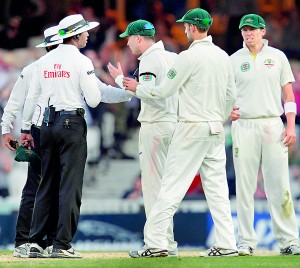Deal with the cinders beneath the Ashes
View(s):From ashes to ashes; dust to dust, Bell tolled for the Aussies and Agar faded to a summer’s dream.
However much I tried to clip it from my thoughts, this willow war between the queen’s two sons just kept rushing back to me. The margin of skill was almost the same between the two teams. Yet, the difference between them was that the Englishmen believed in themselves while the Australians believed in neither themselves nor their captain. Nevertheless, it was an intriguing battle of wits where man-to-man skills were equal.
Yet still there are more questions than answers. Though it may not have totally contributed to the final outcome of the series, some of the ICC promoted cricketing norms went drastically awry.
However, when a bee stings next door Perera there is hardly a hum. But when a bee stings Minister Silva’s son it becomes headline news the next day. The same theory applies to everything on earth and what transpired during the Ashes series and what’s generally wrong with some of the ICC norms are worth probing.
It was well past midnight in Sri Lanka where one hears only about T-20 cricket and how T20 cricket tournaments go all wrong, or some block headed official tries to single out a run-scoring cricketer — some sort of Test cricket keeps us glued to the screen. And the Ashes series is Test cricket.
I feel that Australian captain Michael Clarke was not aware of that famous English (in the sense of the word) cricket terminology – ‘Nelson’ which has almost become a superstition. (For the superstitious Englishmen and even for some of us 111 or its multiplications are a bad omen).
Clarke declared his second inning at 111 for 6 and with a first innings lead of 115; he left the floodgates opened expecting an English batting collapse in the second innings while leaving them a target of 227 to win in 44 overs.

Australia's captain Michael Clarke (C) talks with umpires Aleem Dar (L) and Kumar Dharmasena (2L) before the umpires stop play declaring the light bad with 4 overs to play to end the fifth day of the fifth Ashes cricket test match between England and Ausralia at The Oval cricket ground in London on August 25, 2013. England and Australia drew the fifth Ashes Test at The Oval on Sunday as the hosts wrapped up a 3-0 series win. - AFP
Looking for that face-saving single win, the Australians were happy when they got opener Joe Root cheaply, but when Jonathan Trott steadied the English second innings and then Kevin Pietersen decided to bludgeon the Aussie attack, scoring 62 runs in just 55 balls, the Aussies saw their own boomerang sailing towards them. Then they looked up to the skies and the descending darkness at half past seven in the evening in England.
I wonder what they would have done if England were 181 for 9 when the light was fading, but England were 206 for 5 with four more overs to go. Suddenly the fielders were not seeing the ball while the batsmen were, but according to the laws put in place by the ICC the two umpires, Aleem Dar and Kumar Dharmasena went by the law like what the policemen do in normal civil circumstances, called off the match, thus preventing the Australians from tasting the ignominy of a 4-nill thrashing which would have rewritten Ashes history.
The Australians were so flustered about the outcome that when the umpires were checking the light, Michael Clarke was almost telling them the reading was right to call the game off.
The game was called off at that point and then the next day England Cricket Board (ECB) Chairman Giles Clarke called the decision of the umpires to call off the game totally unsatisfactory and called upon ICC Chief Executive David Richardson to change the regulations regarding bad light at the earliest opportunity. That was one point where Englishmen were robbed of a possible victory.
Then what about the Dar felony when he ruled Englishman Stewart Broad not out when a broad as daylight edge ricocheted off the wicketkeeper to the slips to Australian captain Michael Clarke? The umpire stood firm, the batsman did not walk and England possibly jumped through the wormhole of losing the first Test match of the Ashes series.
The Ashes series was also riddled with controversies such as ‘Dharmasena-gate’ where he as the third umpire upheld the middle umpire’s ruling of a caught behind when the ‘Hotspot’ failed to detect any blotch.
Earlier, ICC Chief Executive Dave Richardson apologised to Giles Clarke after the Hotspot camera could not determine whether or not Trott edged a delivery from Mitchell Starc before it hit his front pad. Third Umpire Marais Erasmus overturned the decision of on-field umpire Dar to give Trott out lbw despite the fact the side-on Hotspot image of the dismissal was not available.
A furious England coach Andy Flower demanded an explanation from match referee Ranjan Madugalle, the ICC’s most senior official, over the lbw dismissal. England wanted to know why Trott was given out and if the match officials followed the proper protocols.
These are some of the incidents that occurred during the recent Ashes series, but there were more. However, we at this end are sure that something positive should happen about these umpiring decisions in the weeks or months to come. We are more than sure those umpiring discrepancies would be looked into because they did occur during an Ashes series.
 Besides the Ashes there are other cinders too in modern day cricket. It was not so long ago I heard one prominent former cricketer/commentaror complaining about the ICC decision not to allow a runner to assist a batsman during a match – a practice which had been there from the inception. If a batsman is injured during an innings he should be allowed the aid of a runner, the commentator argued. That would come right the day an Indian batsman like Sachin Tendulkar is out because he was injured during an innings and he could not continue to run and score – both. Or else it should happen during the next Ashes and it should decide the fate of the series. So is the substitute rule which has come into effect also of late.
Besides the Ashes there are other cinders too in modern day cricket. It was not so long ago I heard one prominent former cricketer/commentaror complaining about the ICC decision not to allow a runner to assist a batsman during a match – a practice which had been there from the inception. If a batsman is injured during an innings he should be allowed the aid of a runner, the commentator argued. That would come right the day an Indian batsman like Sachin Tendulkar is out because he was injured during an innings and he could not continue to run and score – both. Or else it should happen during the next Ashes and it should decide the fate of the series. So is the substitute rule which has come into effect also of late.
Then some other idiotic (to my mind) but accepted rules are the umpires’ calls. I find them hilarious at times. If the umpire rules a batsman out lbw and the ball strikes two centimetres inside the middle of the leg or the off stump his rule stays; if the ball strikes a centimetre on the outside half his calling the rule goes according to his original call. Some find it unacceptable. If the ball is striking in any way, and technology is being implemented then the technology should take precedence. Why? Technology was brought in to rectify human error and then if it is implemented it should come 100 per cent.
Should the light metre issue be argued at an ICC forum, we feel even other issues we have raised also should be given some consideration.
After all cricket is a game that grew from a curved single handled bat and a two stumped wicket with under arm bowling. None of those is in use now. Then if the game has to grow with the times it should be looked into through positive angles and should exclude all possible human errors or else keep that margin for human error and take out technology altogether.
comments powered by Disqus

